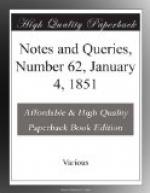NOTES.
Old ballad upon the “Winter’s tale.”
Some of your correspondents may be able to give me information respecting an old ballad that has very recently fallen in my way, on a story similar to that of Shakspeare’s Winter’s Tale, and in some particulars still more like Greene’s novel of Pandosto, upon which the Winter’s Tale was founded. You are aware that the earliest known edition of Greene’s novel is dated 1588, although there is room to suspect that it had been originally {2} printed before that year: the first we hear of the Winter’s Tale is in 1611, when it was acted at court, and it was not printed until it appeared in the folio of 1623.
The ballad to which I refer has for title The Royal Courtly Garland, or Joy after Sorrow: it is in ordinary type, and was “Printed and sold in Aldermary Churchyard, London.” It has no date, and in appearance does not look older than from perhaps, 1690 to 1720; it may even be more recent, as at that period it is not easy to form a correct opinion either from typography or orthography: black-letter has a distinguishing character at various periods, so as to enable a judgment to be formed within, perhaps, ten years, as regards an undated production: but such is not the case with Roman type, or white-letter. What I suspect, however, is that this ballad is considerably older, and that my copy is only a comparatively modern reprint with some alterations; it requires no proof, at this time of day, to show that it was the constant habit of our old publishers of ephemeral literature to reprint ballads without the slightest notice that they had ever appeared before. This, in fact, is the point on which I want information, as to The Royal Courtly Garland, or Joy after Sorrow. Can any of your correspondents refer me to an older copy, or do they know of the existence of one which belongs to a later period? I cannot be ignorant of Dr. RIMBAULT’S learning on such matters, and I make my appeal especially to him.
It is very possible that it may bear a different title in other copies, and for the sake of identification I will furnish a few extracts from the various “parts” (no fewer than six) into which the ballad is divided; observing that they fill a closely printed broadside, and that the production is entirely different from Jordan’s versification of the Winter’s Tale, under the title of The Jealous Duke and the injured Duchess, which came out in his Royal Arbor of Loyal Poesie, 8vo. 1664. It is singular that two ballads, hitherto wholly unknown, should have been written upon the same incidents of the same drama, although we are yet without evidence that Jordan’s effusion was ever published as a broadside.




